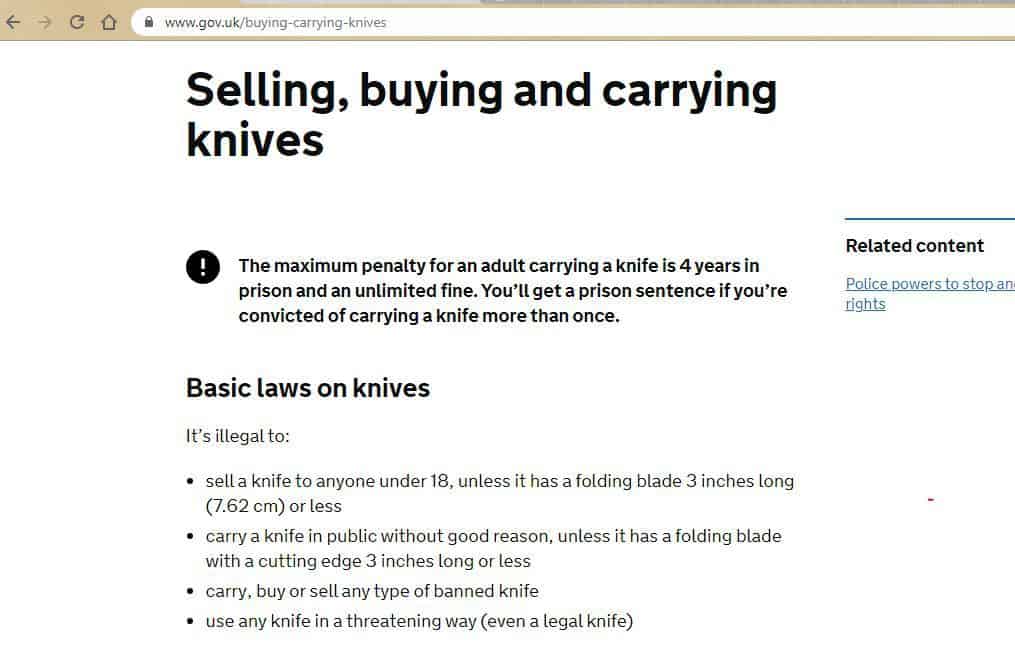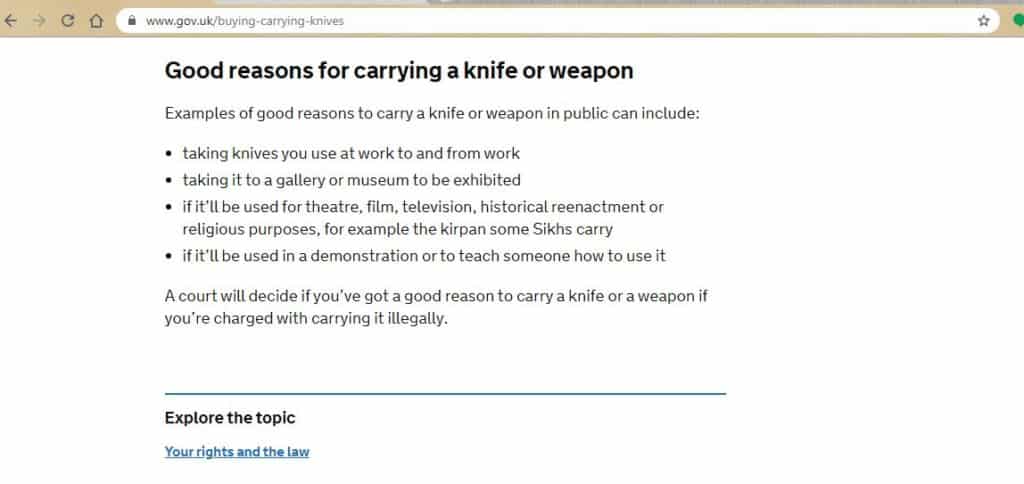
This article takes a look at the law in the UK regarding chefs carrying their knives, and the best methods for storing transporting them safely.
A set of good quality, sharp knives , are perhaps the most important pieces of equipment a chef can own (alongside a comfortable pair of shoes!).
, are perhaps the most important pieces of equipment a chef can own (alongside a comfortable pair of shoes!).
With that in mind we come up against the question of how to transport our knives. Common sense tells us that we cannot walk around wherever we like in public with our knives, but what are the actual laws?
There are times when we need to transport our knives to and from work, as well as taking one home if we go to a physical shop and buy one.
Carrying a knife is illegal under Section 139 of the Criminal Justice Act 1988. However, there are some parts to the law which allow a chef to transport their knives for work purposes.
The Law on Carrying Knives
As stated above, Section 139 of the Criminal Justice Act 1988 makes it an offence to have “any article which has a blade or is sharply pointed” in a public place.
Below is a screen shot taken from the government’s website (www.gov.uk ) clarifying this law.
) clarifying this law.

As we can see this is serious stuff. The maximum penalty for carrying a knife can be an unlimited fine and up to 4 years in prison!
The phrase which allows us chefs to carry our knives in certain situations in public though is, “carry a knife in public without good reason”
When the government made the law they were aware that in certain situations people, such as professional chefs , will have a legitimate reason for carrying their knives in public. After all, how else are we going to transport them between work and home?
, will have a legitimate reason for carrying their knives in public. After all, how else are we going to transport them between work and home?
The government website goes on to clarify examples of what they would consider to be good reasons for carrying a knife, as shown below.

We can see from this screen grab that specific mention is given to “taking knives you use at work to and from work” This is the area which covers chefs in many instances.
There is a whole list of knives which are banned and considered weapons on their website, so readers should check the website themselves (www.gov.uk ) and be extra careful when buying or transporting knives. It is an offence taken very seriously by the courts!
) and be extra careful when buying or transporting knives. It is an offence taken very seriously by the courts!
However it’s very important to remember that what is considered good reason will be decided by the police if questioning you, and ultimately the courts if the police are not satisfied with your response.
As it states at the bottom of the page, “A court will decide if you’ve got a good reason to carry a knife or a weapon if you’re charged with carrying it illegally.”
As an example, if a chef finds themselves in a pub after a shift with their knives in their bag, they may have a very difficult job explaining to the police officer why this was a good reason to have them on their person.
In this instance the chef could get in an awful lot of trouble as it is a very serious issue. So now let’s look at what chefs tend to do with their knives when not working and the methods they use to store them safely.
Do Chefs Keep Their Knives At Work?
With the strictness of the laws regarding travelling with knives, most chefs choose to leave their knives at work on a daily basis.
As chefs, leaving our knives neatly kept underneath our work bench is far more convenient than transporting them forward and backwards between work and home, and potentially running into a difficult conversation a with police officer.
Most chefs are a very respectful bunch when it comes to other chef’s knives. A chef will not go through another person’s box or knife roll without asking their permission first.
when it comes to other chef’s knives. A chef will not go through another person’s box or knife roll without asking their permission first.
Every chef knows that knives are an expensive outlay which need to be handled with care, so long as the chef respects their own knives others will follow suit.
At the end of each shift it is important that we wash our knives ourselves (even if the kitchen has a K.P ), dry them and then place them safely away in our box or wrap.
), dry them and then place them safely away in our box or wrap.
A chef can’t have any complaints if they leave their knives hanging around the kitchen and then discover they have been damaged in some way (such as a heavy pan being dropped on a knife carelessly left by the sink!).
Chefs typically have two choices when it comes to storing our knives. Either a knife box, or a knife roll. There are pros and cons to each which we will look at below.
Why Do Chefs Use Knife Rolls?

Some chefs choose to use knife rolls (or wraps as they are sometimes called) as they are a lightweight solution to protect the knives whilst travelling and also provide quick and easy access to every type of knife when at work.
- A knife roll will have individual pockets for each type of knife that a chef owns. This means they can quickly locate the knife they require, something which can be very important during a busy service.
- Knife rolls are also lightweight and can make placing the roll in a back pack a lot easier in terms of transportation. If a chef is required to use public transport to take their knives to or from work (see earlier for needing a good reason to carry them) placing a knife roll in a back pack is an easier method then carrying a toolbox full of knives.
- They look professional. A roll that is full of individual well-kept knives looks good when it is opened up. There is a certain sense of pride in seeing the tools of the trade laid out beautifully in front of you. Link to the roll pictured above on Amazon here
Despite these good points, and their huge popularity among chefs, some find that there are a few negatives to knife rolls which makes them choose a knife box instead.
Why Do Chefs Use Knife Boxes?

Chefs will often use boxes, either knife specific boxes, or tool boxes to store their knives. The range of equipment a modern chef needs is vast and a traditional knife roll can struggle to accommodate all the different sized pieces of equipment.
Knife rolls are great if we need to regularly transport our knives between work and home. However this is not an issue for most chefs as it is far easier to leave them at work in between shifts.
The problem many find with knife rolls, is that a chef’s range of tools is not limited to just knives.
For example there are slices, pastry rollers, foamers, sharpening stones, piping bags and nozzles, the list is endless.
As we start to accumulate these type of items we realise pretty quickly that a knife roll does not have places to put all these items!
- This makes a lot of chefs turn to boxes instead. In a box we can put all our various shaped tools without worrying they are going to fall out. A chef can purchase a knife specific box, or any tool box like the one above from Amazon, is perfectly good for the task.
- Another benefit of a box is that they are more robust than fabric rolls. Any knocks to the box will not damage the knives inside, this is especially useful when leaving our knives at work. There can be a tendency for overly zealous K.Ps to knock them on the floor whilst pulling benches out to do a deep clean!
- The final advantage of a box is that it has the option to put a lock on it. As stated earlier most chefs are a very respectful bunch
 when it comes to others knives and equipment but this can be useful in some cases.
when it comes to others knives and equipment but this can be useful in some cases.
On occasion, as in all work places, we come across people who are not so great at being team players. If we find that someone is going into our knife box whilst we are away, we can put a padlock on it.; especially useful for days off or holidays.
A disadvantage of a knife box, is that it can take longer to find our knives. Instead of each individual knife being carefully laid out, as is the case with a roll, we have to hunt through our box to find the knife we want, which is often at the bottom!
This leads on to another disadvantage which is the knives have no protection from each other. They are all essentially thrown in together, with nothing really preventing them from bashing against each other when being carried; although we can wrap individual knives in tea towels to alleviate this issue.
The third issue with knife boxes is that they are just not as easy to transport. This is not such a problem when traveling by car but can become difficult on public transport.
To Sum Up
It is really important as chefs that we are careful when carrying our knives to and from work. We must have a good reason and be prepared to explain ourselves to any police officer that questions us.
For these reasons it is best to keep carrying knives outside of work to a minimum.
In terms of protecting our knives, my personal favourite is always to use a knife box. There is a disadvantage that it doesn’t look as good as a neatly packed roll, but I find it far more practical, particularly when working on the pastry section with all the various gadgets needed there!
For beginners with only a few knives a cheap knife roll is probably the way to go. They are inexpensive, and as our knife collection builds we can look at changing to a box; again not a huge investment in comparison to the cost of the knives which they protect.
with only a few knives a cheap knife roll is probably the way to go. They are inexpensive, and as our knife collection builds we can look at changing to a box; again not a huge investment in comparison to the cost of the knives which they protect.
Important: This post is written with the intention to be a helpful guide to people living in the UK. I am in no way a legal authority on the matter of carrying knives and readers should conduct their own research before carrying knives in public. If at all unsure, contact your local police station to check the laws in your area.
